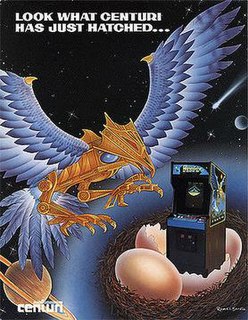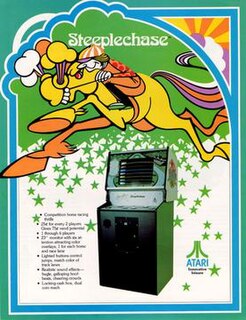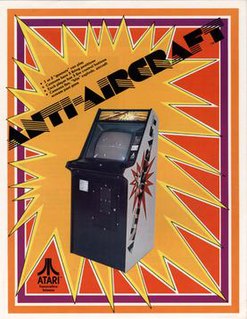
Pole Position is an arcade racing simulation video game that was released by Namco in 1982 and licensed to Atari, Inc. for US manufacture and distribution, running on the Namco Pole Position arcade system board. It is considered one of the most important titles from the golden age of arcade video games. Pole Position was an evolution of Namco's earlier arcade racing electro-mechanical games, notably F-1 (1976), whose designer Sho Osugi worked on the development of Pole Position.

Centipede is a 1981 fixed shooter arcade game developed and published by Atari, Inc. Designed by Dona Bailey and Ed Logg, it was one of the most commercially successful games from the golden age of arcade video games and one of the first with a significant female player base. The primary objective is to shoot all the segments of a centipede that winds down the playing field. An arcade sequel, Millipede, followed in 1982.

Breakout is an arcade game developed and published by Atari, Inc., and released on May 13, 1976. It was conceptualized by Nolan Bushnell and Steve Bristow, influenced by the seminal 1972 Atari arcade game Pong. In Breakout, a layer of bricks lines the top third of the screen and the goal is to destroy them all by repeatedly bouncing a ball off a paddle into them. The arcade game was released in Japan by Namco. An Atari VCS port was released in 1978 which used color graphics instead of a monochrome screen with a colored overlay.

Ikari Warriors, known as Ikari in Japan, is a vertically-scrolling, run-and-gun shooter arcade game developed and released by SNK in 1986, and released in North America by Tradewest. The game was released at the time when there were many Commando clones on the market. What distinguished Ikari Warriors were rotary joysticks and a two-player mode. The rotary joystick controls were in turn based on SNK's earlier TNK III (1985). Ikari was originally intended it to be an official licensed adaptation of the film Rambo: First Blood Part II (1985), but SNK were initially unable to acquire the rights to the film. Ikari Warriors went on to be a major global success, becoming one of the highest-grossing arcade games of 1986.

Choplifter is military themed scrolling shooter developed by Dan Gorlin for the Apple II and published by Broderbund in 1982. It was ported to Atari 5200, Atari 8-bit family, ColecoVision, Commodore 64, VIC-20, MSX, and Thomson computers. Graphically enhanced versions for the Atari 8-bit family and Atari 7800 were published in 1988 by Atari Corporation.

Time Pilot is a multidirectional shooter arcade game designed by Yoshiki Okamoto and released by Konami in 1982. It was distributed in the United States by Centuri, and by Atari Ireland in Europe and the Middle East. While engaging in aerial combat, the player-controlled jet flies across open airspace that scrolls indefinitely in all directions. Each level is themed to a different time period. Home ports for the Atari 2600, MSX, and ColecoVision were released in 1983.

Jungle Hunt is a platform game developed by Taito and released in arcades in 1982. Initially distributed as Jungle King, it was modified and re-released as a result of a copyright dispute over the player character's likeness to Tarzan.

Phoenix is a fixed shooter arcade game released in December 1980. Developed in Japan by either Hiraoka or TPN, the game was released in Japan by Taito in December 1980. It was then released in Europe, and then in the Americas by Centuri and Amstar Electronics in January 1981.

Star Wars is a first-person rail shooter video designed by Mike Hally and released in arcades in 1983 by Atari, Inc. It uses 3D color vector graphics to simulate the assault on the Death Star from the 1977 film Star Wars. Developed during the Golden Age of Arcade Games, Star Wars has been included on lists of the greatest video games of all time.

Combat is a video game by Atari, Inc. for the Atari 2600. It was released as one of the nine launch titles for the system in September 1977, and was included in the box with the system from its introduction until 1982. Combat was based on two earlier black-and-white coin-operated arcade games produced by Atari: Tank in 1974 and Jet Fighter in 1975.
Combat flight simulators are vehicle simulation games, amateur flight simulation computer programs used to simulate military aircraft and their operations. These are distinct from dedicated flight simulators used for professional pilot and military flight training which consist of realistic physical recreations of the actual aircraft cockpit, often with a full-motion platform.

Pole Position II is the sequel to racing simulation game Pole Position, released by Namco for arcades in 1983. As with its predecessor, Namco licensed this game to Atari, Inc. for US manufacture and distribution, who also released a port of it as the pack-in game for their Atari 7800 ProSystem console. Pole Position arcade machines can be converted to Pole Position II by swapping several chips.

Vanguard is a scrolling shooter arcade game developed by TOSE. It was released by SNK in Japan and Europe in 1981, and licensed to Centuri for manufacture in North America in October and to Zaccaria in Italy the same year. Cinematronics converted the game to cocktail arcade cabinets in North America.

Sprint 2 is a two player overhead-view arcade racing video game released in 1976 by Kee Games, a wholly owned subsidiary of Atari, and distributed by Namco in Japan. While earlier driving games had computer-controlled cars that moved along a "canned predetermined" course, Sprint 2 "introduced the concept of a computer car that had the intelligence to drive itself around the track" in "a semi-intelligent" manner.

Hi-way, also known as Highway, is a 1975 single-player arcade racing game by Atari Inc. Marketed with the slogan “Hi Way — All It Needs Is Wheels,” it was Atari's first game to use a sit-down arcade cabinet.

Steeplechase is an arcade sports video game by released in 1975 by Atari, Inc. Developed by Atari subsidiary Kee Games, it simulates a steeplechase-style horse race. It was distributed in Japan by Nakamura Seisakusho (Namco) in 1976.

Anti-Aircraft is a two-player fixed shooter released in arcades by Atari, Inc in 1975. The game was also released as Anti-Aircraft II, denoting the two-player aspect of the game.

Dogfight is an aerial combat video game written by Bill Basham for the Apple II and published by Microlab in 1980. The game is a clone of Atari, Inc.'s 1975 arcade game Jet Fighter.

Speed Race is a 1974 arcade racing video game developed and manufactured by Taito, and released under the titles Racer and Wheels in North America by distributor Midway Manufacturing in 1975. Designed by Tomohiro Nishikado, the gameplay involves the player using the attached steering wheel to maneuver a car alongside a fast vertical scrolling road. The objective is to score points by driving past other cars without colliding with them; more points are awarded for driving faster. Players must do this under a 90-second time limit, which ends the game when it runs out. The gameplay concepts were adapted from two earlier driving electro-mechanical games: Kasco's Mini Drive (1958) and Taito's Super Road 7 (1970).

An arcade game or coin-op game is a coin-operated entertainment machine typically installed in public businesses such as restaurants, bars and amusement arcades. Most arcade games are presented as primarily games of skill and include arcade video games, pinball machines, electro-mechanical games, redemption games or merchandisers.



















